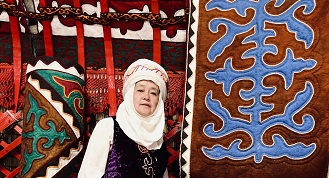Guardians of the Silk Road's Heritage: Women of the mountains of Central Asia

1 October 2022 to 21 May 2023
This exhibition showcased the work of the professional artists and craftswomen who do so much to preserve and transfer traditional knowledge and skills, adapting them for new audiences and popularising Central Asian folk art. Examples of their textile work were exhibited alongside photographs of the women practicing a variety of traditional craft techniques.
A landscape of open plains and the highest mountains on earth, cut with deep valleys whose rivers feed most of Asia. For thousands of years this landscape witnessed processions of caravans carrying cargoes of spices and silks, along with ideas and innovations, heading along the ancient silk routes joining east and west. Cities grew up and grew rich from the trade, forts were built to defend and control it, and shrines served the spiritual needs of those undertaking the long, arduous journey.
With the rise of sea trade in the age of sail and then steam the importance of these land routes shrank. But now there is talk of the ‘New Silk Roads’ sparked by China’s vast ‘Belt and Road Initiative’. It aims to create transit corridors across what they call the ‘Eurasian land bridge’ connecting China to Europe. The mountains of Central Asia will once again become a world of trade and transport.
People living along these routes fear that their way of life may be destroyed while others see opportunities to bring local arts and crafts to new audiences. It is set against this backdrop of uncertainty that the GCRF Resilient Silk Route Heritage Network aimed to foster ways for local communities to develop their cultural heritage, commercially and creatively. To make cultures move once more across the mountains, to learn from each other and work together.
The GCRF Silk Routes Heritage Network was funded by UK Research and Innovation through the Global Challenges Research Fund and is a collaboration between Durham University, the University of Central Asia and the NGO Laajverd. This exhibition was made possible with support from the Economic and Social Research Council of the UK.


/prod01/channel_4/things-to-do/media/things-to-do/oriental-museum/88326-2000X665.jpg)